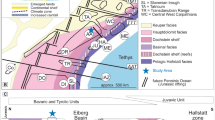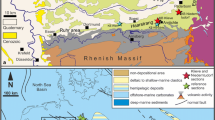Abstract
The siliciclastic, up to 4,000 m thick Upper Triassic–Bajocian Shemshak Formation is widespread across the Iran Plate, especially in the Alborz Mountains of northern Iran. In contrast to its lower, generally non-marine part, the upper part is marine. Based on the Tazareh section of the eastern Alborz, an integrated analysis of this marine interval is presented. The 1,700 m thick marine sedimentary succession records a gradual deepening from inner to mid and outer shelf environments from the Middle Toarcian to early Late Aalenian. During the Late Aalenian–Early Bajocian, the trend was reversed and infilling of the basin by a large delta system occurred. This general facies development reflects a nearly symmetrical transgressive–regressive (T–R) megacycle, terminated by the inter-regional mid-Cimmerian tectonic event. A renewed transgression in the early Late Bajocian initiated a subsequent sedimentary megacycle. The bioturbated mid and outer shelf sediments contain a low to moderately diverse benthic fauna dominated by deep burrowing bivalves, often preserved in the growth position. A hierarchy of four orders of sedimentary cycles can be recognized (parasequences, parasequence sets, unconformity-bounded third-order depositional sequences, and the 13 ma long second-order T–R megacycle). A regional correlation with the Jajarm area (200 km to the east) shows a very similar temporal facies pattern of the upper Shemshak Formation. The eastern Alborz T–R cycle is completely out-of-phase with other (eustatic) sea-level curves, suggesting regional tectonic control. Rough estimates of subsidence rates give an average value of 126 m/ma. However, much higher values for the Aalenian (230 m/ma), particularly the Late Aalenian (700 m/ma), indicate a distinct increase in subsidence rate towards the Early Bajocian mid-Cimmerian tectonic event. These high subsidence rates suggest that the sediments of the Shemshak Formation of the eastern Alborz formed in a (young) rift basin.











Similar content being viewed by others
References
Alavi M (1996) Tectonostratigraphic synthesis and structural style of the Alborz Mountain system in northern Iran. Geol Soc Am Bull 103:983–992
Assereto R (1966) The Jurassic Shemshak Formation in central Elburz (Iran). Riv Ital Paleont Stratigr 72:1133–1182
Brenchley PJ, Newall G, Stanistreet IG (1979) A storm surge origin for sandstone beds in an epicontinental platform sequence, Ordovician, Norway. Sediment Geol 22:185–217
Brunet M-F, Korotaev MV, Ershov AV, Nikishin AM (2003) The South Caspian Basin: a review of its evolution from subsidence modelling. Sediment Geol 156:119–148
Ebinger CJ (1989) Tectonic development of the western branch of the East African rift system. Geol Soc Am Bull 101:885–903
Einsele G (2000) Sedimentary basins. Evolution, facies, and sediment budget. Springer, Berlin, Heidelberg, New York, 792 pp
Fürsich FT, Oschmann W, Singh IB, Jaitly AK (1992) Hardgrounds, reworked concretion levels and condensed horizons in the Jurassic of western India: their significance for basin analysis. J Geol Soc London 149:313–331
Fürsich FT, Pandey DK, Callomon JH, Jaitly AK, Singh IB (2001) Marker beds in the Jurassic of the Kachchh Basin, western India: their depositional environment and sequence-stratigraphic significance. J Palaeont Soc India 46:173–198
Fürsich FT, Oschmann W, Pandey DK, Jaitly AK, Singh IB, Liu C (2004) Palaeocology of Middle to lower Upper Jurassic macrofaunas of the Kachchh Basin, Western India – an overview. J Palaeont Soc India 49:1–26
Fürsich FT, Hautmann M, Senowbari-Daryan B, Seyed-Emami K (2005) The Upper Triassic Nayband and Darkuh formations of east-central Iran: facies patterns and palaeontology in an extensional basin. Beringeria 35
Gradstein FM, Aghterberg FP, Ogg JG, Hardenbol J, Van Veen P, Thierry J, Huang Z (1994) A Mesozoic time scale. J Geophys Res 99(12):24051–24074
Hallam A (1988) A reevaluation of Jurassic eustasy in the light of new data and the revised Exxon curve. In: Wilgus CK, Hastings BS, Kendall CGSC, Posamentier HW, Ross CA, Van Wagoner JC (eds) Sea level changes – an integrated approach. SEPM Spec Publ 42:261–273
Hamblin AP, Walker RG (1979) Storm-dominated shelf deposits: the Fernie-Kootenay (Jurassic) transition, southern Rocky Mountains. Can J Earth Sci 16:1156–1167
Hardenbol J, Thierry J, Farley MB, Jaquin T, de Graciansky P, Vail PR (1998) Mesozoic and Cenozoic sequence chronostratigraphic framework of European basins – Chart 6: Jurassic sequence chronostratigraphy. In: de Graciansky P, Hardenbol J, Jaquin T, Vail PR (eds) Mesozoic and Cenozoic sequence stratigraphy of European basins. SEPM Spec Publ 60
Harms JC, Southard JB, Spearing DR, Walker RG (1975) Depositional environments as interpreted from primary sedimentary structures and stratification sequences. SEPM Short Course 2:1–161
Jacquin T, Graciansky P-C de (1998) Major transgressive/regressive cycles: the stratigraphic signatures of European basin development. In: de Graciansky P, Hardenbol J, Jacquin T, Vail PR (eds) Mesozoic and Cenozoic sequence stratigraphy of European basins. SEPM Spec Publ 60:15–29
Mount J (1985) Mixed siliciclastic and carbonate sediments: a proposed first-order textural and compositional classification. Sedimentology 32:435–442
Mutti E, Tinterri R, Benevelli G, di Biase D, Cavanna G (2003) Deltaic, mixed and turbidite sedimentation of ancient foreland basins. Mar Petrol Geol 20:733–755
Myrow PM, Southard JB (1996) Tempestite deposition. J Sediment Res 66:875–887
Myrow PM, Fischer W, Goodge JW (2002) Wave-modified turbidites: combined flow shoreline and shelf deposits, Cambrian, Antarctica. J Sediment Res 72:641–656
Rad FK (1986) A Jurassic delta in the eastern Alborz, NE Iran. J Petrol Geol 9:281–294
Reineck H-E, Singh IB (1971) Der Golf von Gaeta/Tyrrhenisches Meer. 3. Die Gefüge von Vorstrand- und Schelfsedimenten. Senckenbergiana Marit 3:185–201
Repin YuS (1987) Stratigraphy and paleogeography of coal-bearing sediments of Iran. Unpublished Report, Natl Iran Steel Comp, Tehran, 1:1–326; 2:1–198; 3:37 [in Farsi]
Röhl H-J (1998) Hochauflösende palökologische und sedimentologische Untersuchungen im Posidonienschiefer (Lias ɛ) von SW-Deutschland. Tübinger Geowiss Arb, A 47:1–170
Saidi A, Brunet M-F, Ricou L-E (1997) Continental accretion of the Iran Block to Eurasia as seen from Late Paleozoic to Early Cretaceous subsidence curves. Geodin Acta 10:189–208
Seilacher A (1967) Bathymetry of trace fossils. Mar Geol 5:513–528
Sengör AMC (1990) A new model for the Paleozoic–Mesozoic tectonic evolution of Iran and implications for Oman. In: Robertson AHF, Sarle MP, Ries AC (eds) The geology and tectonics of the Oman region. Geol Soc London Spec Publ 37:119–181
Seyed-Emami K (2003) Triassic in Iran. Facies 48:91–106
Seyed-Emami K, Alavi-Naini M (1990) Bajocian stage in Iran. Mem Descrit Carta Geol Ital 40:215–221
Seyed-Emami K, Fürsich FT, Wilmsen M (2004) Documentation and significance of tectonic events in the northern Tabas Block (east-central Iran) during the Middle and Late Jurassic. Riv Ital Paleont Stratigr 110(1):163–171
Seyed-Emami K, Fürsich FT, Wilmsen M, Majidifard MR (in press) Ammonites from the Shemshak Formation (Toarcian and Aalenian) of the Jajarm area (eastern Alborz). Paläont Z
Stampfli GM (1978) Etude géologique générale de l’Elburz oriental au S de Gonbad-e-Qabus, Iran N-E. Fac Sci Univ Genève, Thesis No. 1868, 329 pp
Stampfli G, Marcoux J, Baud A (1991) Tethyan margins in space and time. Palaeogeogr Palaeoclimatol Palaeoecol 87:373–409
Stöcklin J (1974) Possible ancient continental margin in Iran. In: Burk CA, Drake CL (eds) The geology of continental margins. Springer, Berlin, Heidelberg, New York, pp 873–887
Vail PR, Audemard F, Bowman SA, Eisner PN, Perez-Cruz C (1991) The stratigraphic signatures of tectonics, eustasy and sedimentology – an overview. In: Einsele G, Ricken W, Seilacher A (eds) Cycles and events in stratigraphy. Springer, Berlin, pp 617–659
Vollmer T (1987) Zur Geologie des nördlichen Zentral-Elburz zwischen Chalus- und Haraz-Tal, Iran. Mitt Geol Paläont Inst Univ Hamburg 63:1–125
Van Wagoner JC, Posamentier HW, Mitchum RM, Vail PR, Sarg JF, Loutit TS, Hardenbol J (1988) An overview of the fundamentals of sequence stratigraphy and key definitions. In: Wilgus CK, Hastings BS, Kendall CGSC, Posamentier HW, Ross CA, Van Wagoner JC (eds) Sea-level changes – an integrated approach. SEPM Spec Publ 42:39–44
Wilmsen M, Fürsich FT, Seyed-Emami K (2003) Revised lithostratigraphy of the Middle and Upper Jurassic Magu Group of the northern Tabas Block, east-central Iran. Newsl Stratigr 39:143–156
Wright LD (1985) River deltas. In: Davies RA (ed) Coastal sedimentary environments. Springer, New York, pp 1–76
Wright LD, Coleman JM (1974) Mississippi river mouth processes: effluent dynamics and morphologic developments. J Geol 82:751–778
Zonenshain LP, Le Pichon X (1986) Deep basins of the Black Sea and Caspian Sea as remnants of Mesozoic back-arc basins. Tectonophysics 123:181–211
Acknowledgements
The research has been carried out within the framework of the Middle East Basin Evolution programme (MEBE) and within the institutional partnership of the Faculty of Engineering, Tehran University, and the Institute of Palaeontology, University of Würzburg, sponsored by the Alexander von Humboldt Foundation. We would like to thank the University of Tehran (Center of Intelligence) and acknowledge the logistic support by the Geological Survey of Iran and the hospitality of Eng. Sedighifar, head of the East Alborz Coal Company. J. Taheri, GSI Mashad, and M. R. Sheikholeslami, GSI Tehran, assisted us in the field. Helpful reviews by M. Aberhan (Berlin) and W. Piller (Graz) are gratefully acknowledged. Last but not the least we thank M.F. Brunet (Paris) for helpful discussions
Author information
Authors and Affiliations
Corresponding author
Rights and permissions
About this article
Cite this article
Fürsich, F.T., Wilmsen, M., Seyed-Emami, K. et al. The upper Shemshak Formation (Toarcian–Aalenian) of the Eastern Alborz (Iran): Biota and palaeoenvironments during a transgressive–regressive cycle. Facies 51, 365–384 (2005). https://doi.org/10.1007/s10347-005-0051-z
Received:
Accepted:
Published:
Issue Date:
DOI: https://doi.org/10.1007/s10347-005-0051-z




